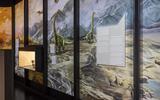MEK – K1 T1 I1 – Catastrophes and opportunities
66 million years ago, the Earth suffered another catastrophic event: a meteorite around 14 kilometres wide struck with incredible force. Three quarters of all plants and animals did not survive this disaster.
The projectile from space hurled vast amounts of pulverised rock into the atmosphere. The whole world became dark and cold for many years .
Herbivores ran out of food, and predators soon found no more prey. The dinosaurs vanished from the Earth.
But life finds a way: for birds and mammals, this catastrophe was an opportunity. They evolved into a rich diversity of life forms, which now shape life on Earth.
No other group of prehistoric animals is as fascinating for humans as the dinosaurs. These magnificent creatures successfully populated the Earth for 180 million years. Modern humans, including our ancestors, have only managed around 3 million years so far.
Armoured, horned, beaked or with savage teeth, colossal or chicken-sized – the highly adaptable dinosaurs would perhaps still today occupy every niche from steppe to swamp if they had not been wiped out by the cosmic catastrophe.
Among the other creatures disappearing at the same time were the mighty pterosaurs, also characteristic of the Cretaceous period.
In the Cretaceous period, 66 million years ago, everything seemed to be hunky-dory: pterosaurs circled overhead, and dinosaurs fed on the luxuriant vegetation or pursued any prey that came their way. The oceans were teeming with diverse life.
But within a matter of seconds, everything changed: a meteorite around 14 kilometres wide struck in the vicinity of what is now the Yucatán Peninsula in Mexico, causing shock waves, wildfires and tsunamis.
Forests burned, storms swept across the Earth, and acid rain fell, turning the oceans into dead zones. The end had come – and yet life went on.
Pterosaurs are the largest flying creatures that have ever lived. With wingspans of up to 12 metres, some were as large as gliders. They ruled the skies for 160 million years.
But they were all wiped out by the catastrophe. Their realm was taken over by the only surviving dinosaurs – the birds.
Eat a lot, excrete a lot: the mighty hunter T. rex left sizeable droppings. 66 million years later, this specimen was discovered in fossilised form.
Half of the coprolite consists of chewed bones – but its size, and the site and stratum where it was found, also clearly indicate that it came from T. rex.
→ Object in the floor display case
Dinosaurs are extinct? No! Some survive – in the form of birds. They are just as much “real” dinosaurs as their famous relative T. rex.
Tree-dwelling birds disappeared as the forests were destroyed. But ground-dwelling birds survived, evolving into a rich diversity of species.
Unsuspected relatives amidst the inferno: in creatures such as Eomaia – which already carried their young internally – lay the seeds of human evolution.
Early mammals of this kind outlived the dinosaurs and took over their habitats. They are the ancestors of modern mammals, from the shrew to the blue whale – and human beings, too.
The meteorite which struck Earth 66 million years ago looked something like this, only much bigger: a lump of rock around 14 kilometres wide, a fragment of an asteroid.
This fate will befall Earth again – but humankind is very unlikely to experience it.
2025: Thousands of small heavenly bodies – asteroids – have been detected close to Earth. Of these, only a few hundred are large enough to cause global damage in the event of an impact, and none of them are on a collision course. Comets can, however, appear unexpectedly. Even so, major impacts are rare.
A dinosaur leaves a footprint in mud. By good fortune, rather than being washed away, it is preserved as a fossilised track.
These trace fossils also tell us a lot about the creatures that left them – Where were they going? Who with? And how did they move?
→ Object in the floor display case
- A: Neovenator, carnivorous dinosaur, 3.5 m tall, footprint in floor showcase
- B: An ancestor of present-day birds, 0.8 m wingspan
- C: Pterosaur, flying reptile, standing 3 m tall, 12 m wingspan
- D: Titanosaur, herbivorous dinosaur, 3.5 m tall
- E: T. rex, carnivorous dinosaur, 7.6 m tall, fossil dung (coprolite) in floor showcase
- F: Triceratops, herbivorous dinosaur, 3 m tall, bone in floor showcase
- G: Eomaia, an early ancestor of modern mammals – including humans – 0.1m long
Like all inhabitants of the Earth, we humans are inextricably bound up with the history of our home, this planet.
We have evolved, over an inconceivably long period, from a series of astonishing ancestors – in most cases, the relationship is not immediately obvious. Shown here are just a few important stages in this process.
Discover our astonishing relatives!
- Human
-
Homo sapiens
170 cm
ab 0.3 Mio. Jahre
Holozän
- Early monkey
-
Aegyptopithecus
60 cm
38-29 Mio. Jahre
spätes Eozän – frühes Oligozän
- Early primate
-
Purgatorius
20 cm
65 – 57 Mio. Jahre
Paleozän
- Early mammal with placenta
-
Eomaia
15 cm
130 – 125 Mio. Jahre
frühe Kreide
- Early mammal
-
Morganucodon
11 cm
220 – 170 Mio. Jahre
späte Trias – mittlerer Jura
- Mammal-like reptile
-
Dimetrodon
350 cm
300 – 272 Mio. Jahre
frühes Perm
- Mammal-like reptile
-
Haptodus
150 cm
310 – 285 Mio. Jahre
spätes Karbon – frühes Perm
- First animal with “spine”
-
Myllokunminigia
2.8 cm
525 – 520 Mio. Jahre
frühes Kambrium
- Early single-celled organism
-
0.0001 – 0.00001 cm
Ab 3'600 Mio. Jahre
frühes Präkambrium
